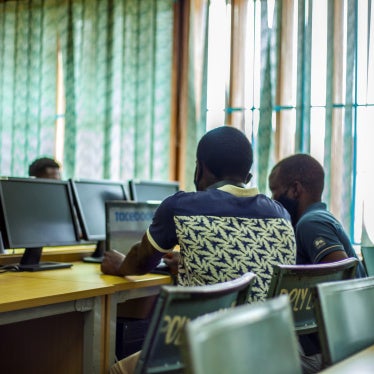(New York) - As the United Nations Secretary-General prepares to visit Sierra Leone, Human Rights Watch today released fresh evidence that civilian suffering continues unabated in the civil war there. In addition to providing details of ongoing atrocities by the rebel Revolutionary United Front (RUF), Human Rights Watch also documented how armed factions fighting on behalf of the Sierra Leonean government have also attacked civilians in recent months.
Human Rights Watch called on UN Secretary-General Kofi Annan to ensure that UNAMSIL, the UN forces in Sierra Leone, do more to protect civilians. In a letter to the Secretary-General, Human Rights Watch urged that the Special Court for trying war crimes in Sierra Leone should be created without further delay and be given "Chapter VII powers" to enforce cooperation, and that it have jurisdiction over crimes committed from the beginning of the war in March 1991, instead of only since November 30, 1996.
Human Rights Watch also warned that the United Nations should enforce the international arms embargo against the RUF, which is now making incursions and committing abuses against civilians in neighboring Guinea.
Recent Abuses Documented by Human Rights Watch in Sierra Leone and Guinea
Abuses by Revolutionary United Front in Sierra Leone Abuses by RUF in Guinea Abuses by Civil Defense Forces Child Combatants Sierra Leone Army (SLA) Abuses
Since the resumption of hostilities in May 2000, Human Rights Watch has taken scores of testimonies from victims and witnesses of abuses taking place within Port Loko, Kambia, Makeni, Lunsar, Kono, Kenema and Kabala districts. While our research suggests that the RUF continue to commit the overwhelming majority of atrocities - including rape, murder, abduction, forced conscription, and amputation - we note with concern the rising number of serious abuses by the Civil Defense Forces (CDF, primarily the Kamajors and Gbithis) including rape, systematic extortion, looting of villages, commandeering of vehicles, recruitment of children, and torture and summary execution of suspected rebels. We have also documented RUF attacks on Guinean villages and civilians.
The following is a chronology of some of these violations and atrocities documented by Human Rights Watch in both Sierra Leone and Guinea since May 2000.
Abuses by Revolutionary United Front in Sierra Leone
August 9-10: RUF rebels conducted a recruitment operation in villages around the northern town of Kabala in which some forty civilians, mostly young men, were rounded up and "tattooed" with the letters R-U-F by a rebel commander. The tattooing was done by cutting 1-2 inch letters into the upper chest with a razor blade or knife. Human Rights Watch interviewed twelve of those, including three adolescent girls, who managed to escape after being "tattooed." Victims described the rape of at least eleven girls by the RUF during the operation.
July 28: A family from a small village in diamond-rich Kono district were "tried" and brutally "punished" for having defied the rebels' authority over mining and other issues. In the attack, one woman and two adolescents were executed, the hand of another woman was amputated, and yet another was gang-raped by the four RUF rebels perpetrating the attack.
July 12-15: Civilians fleeing Makeni in July described two waves of forced recruitment by the RUF. In the first stage, which began around July 12 and lasted for three days, hundreds of men and adolescent boys were seized in marketplaces, taken off trucks, or abducted from their homes. In the second wave starting July 21, the elders and chiefs from around Makeni were summoned for a meeting and told they had two weeks to provide thirty males from each of their chiefdoms. Forced conscription has also been reported around Kabala, Kono and Kambia Districts. Several witnesses said the RUF told the new recruits they were later to be sent to wage war against Guinea.
July 3-5: Elders from villages around the town of Magbele, in Port Loko District described seeing the bodies of seven men who had either been hung or had their necks broken through torture, during a series of rebel attacks. Several other witnesses described the abduction of six women and one young man during the same attack. Three of these women, including one who was eight months pregnant, were raped.
July 3: A 25-year-old women was one of nine women raped by rebels, including boy soldiers, during an attack on the town of Madigba, Port Loko District. She had been pregnant and lost the baby after being raped by five men.
Late June: A 33-year-old mother of six described how her husband was executed and decapitated by RUF rebels after he tried to stop them from abducting their 15-year-old daughter. Eleven other youths were abducted in the attack which took place as the civilians tried to flee the rebel-held town of Makeni.
Mid-June: A 45-year-old mother of eight saw her 21-year-old daughter and her newborn gunned down in front of her during an RUF attack on the town of Funkun, in the Northern Kambia District. They were, according to several witnesses, among seven civilians killed and over thirteen abducted in the same mid-June raid. Nine of those who were abducted were adolescents.
Mid-May: A 12-year-old girl from Mange-Burre in Northern Kambia District had her left hand amputated by RUF rebels after being captured along with some ten other village girls and adolescents while washing clothes in a stream.
Abuses by RUF in Guinea
September 15: A 15-year-old boy recuperating in a Freetown hospital described how he was wounded and five young men were killed by RUF combatants when they attacked the Guinean town of Kolakuri. The victim said the RUF fired directly into a house in which he and nine of his friends were hiding.
September 6: Several residents of the Guinean border town of Pamelap verified the involvement of RUF combatants, including high-level commanders, in an attack on the town. One man interviewed by Human Rights Watch witnessed an RUF combatant gun down two Guinean traders and one Guinean policeman. Other witnesses saw the bodies of at least fifteen other victims and verified the abduction of up to fifteen Guinean women who were later taken into Sierra Leone by the retreating RUF. One Sierra Leonean refugee living in the town witnessed the abduction by the RUF of two Italian Catholic priests who are still in their custody at this writing.
Abuses by Civil Defense Forces
October 10: A local journalist was abducted from his office and taken away in a car with tinted windows to a Kamajor base in Freetown. Inside this base, he was beaten by Kamajor officers who accused him of having written unfavorable articles about the Kamajors, and in particular about their leader, Deputy Minister of Defense, Chief Sam Hinga Norman. The journalist was held for two days before being freed.
August 16: An official convoy carrying Chief Norman and the Sierra Leonean Vice President, Joe Demby, was briefly delayed crossing a damaged bridge near the southern town of Mabang by a public bus which had gotten stuck by a broken plank. Human Rights Watch researchers spoke with five witnesses who described how Chief Norman personally ordered his security detail to open fire on the bus after becoming irritated at having to wait for it to be removed from the bridge. While the bus was empty at the time, the ricocheting bullets wounded two civilians. Chief Norman later refused to take the wounded to Freetown for treatment.
August 14: A 45-year-old truck driver was severely beaten and lost several teeth, and another was beaten and held "prisoner" for several hours in a closed storage container by Kamajors controlling an extortion racket on a key bridge leading to the Southern and Eastern Provinces. The Kamajors manning the Mabang bridge routinely extort large sums of money from anyone wanting to take a vehicle across and subject drivers to excessive brutality if they are unable to pay their "tax." Human Rights Watch researchers visiting the area spoke with several drivers who had waited up to three days to cross the bridge because they could not produce the amount required by the Kamajors.
Mid-July: Three women described being raped by Kamajor fighters in the Southern town of Moyamba after the mini-bus in which they were traveling was detained and all the occupants "accused" of transporting goods to rebel held areas. One of the women interviewed was raped by one of the Kamajor commanding officers and others were raped within the CDF headquarters in Moyamba Town. Another was severely beaten on the head with a flashlight while resisting the sexual assault.
July 19: A 29-year-old RUF "Discipline Officer" interviewed by Human Rights Watch inside a jail in Kenema, described being tortured by Kamajor militiamen after his capture. He said the Kamajors dropped burning pieces of plastic on his left arm, and cut him on the legs and shoulders with a knife. Human Rights Watch verified the injuries described.
July 17: A civilian from the northern town of Batkanu described seeing the head of a young RUF combatant on a stick at the entrance to the town. The RUF fighter had earlier that day been executed by Gbethi CDF militias who accused him of spying. The young RUF fighter had allegedly tried to surrender.
July 15: Villagers fleeing RUF repression and forced conscription in the town of Gbendembu described being later captured, tortured, and robbed by CDF Gbethi fighters who accused them of being rebel sympathizers. Many residents of Makeni who in June and July fled forced RUF recruitment and attacks by the government helicopter gunship, described similar incidents. In one such incident on July 18, a young man who sold cigarettes in Makeni market was executed.
July 15: An elder from Kangahun village, 12 miles from Moyamba, described how Kamajor fighters raided the village of Kangahun (Moyamba District.) In the attack the Kamajors beat up several residents, rounded up and stole all the livestock, and extorted money from the villagers.
July 12: A Sierra Leonean Army vehicle carrying an army paymaster with 9 million leones ($3,830 USD) in salaries was robbed by Kamajor fighters near Moyamba Junction. The money was shared among nine Kamajors and the local commander. The Kamajor authorities received considerable pressure to return the money to the army and some of it eventually was. é
Early June: A Kamajor fighter described how militiamen from his unit raped two village girls they had come across in the bush while patrolling near Rogberi Junction. He said the fighters accused the girls of being rebel sympathizers.
Child Combatants
Human Rights Watch and other credible witnesses and organizations have verified the continued use of child and adolescent combatants by Kamajor and Gbethi militias. Numerous children and adolescents, as young as 11, have been spotted manning checkpoints along the Freetown - Mile 91 highway, and around the towns of Moyamba, Yele and Bo.
Sierra Leone Army (SLA) Abuses
A 24-year-old farmer from the Northern village of Alikalia described being tortured by an SLA lieutenant who accused her of being an RUF rebel. The woman had earlier this year been abducted and briefly held by the RUF. After being detained at a checkpoint outside of Kabala, she was severely beaten in the body and face, whipped and bound by wire at the elbows.








